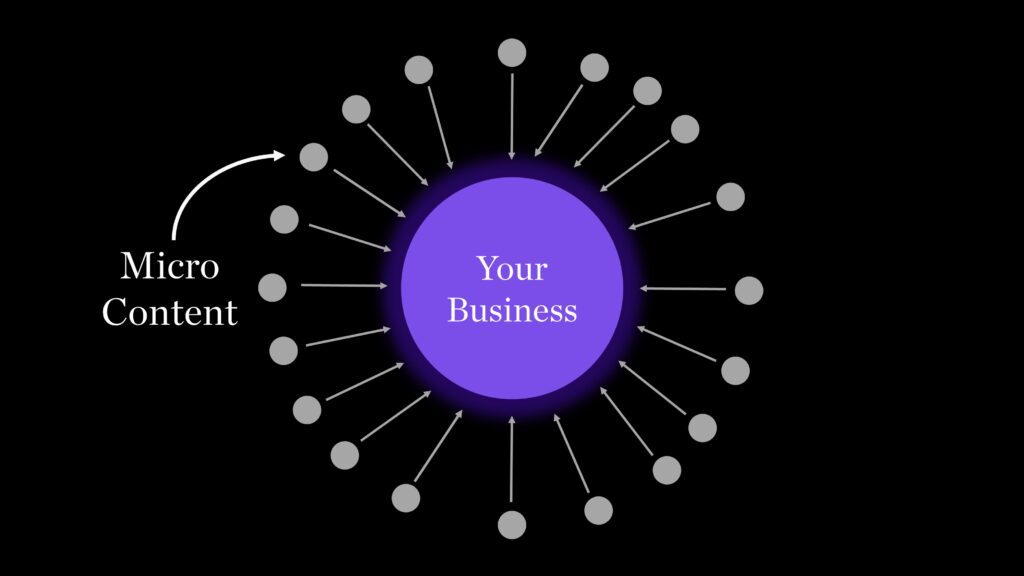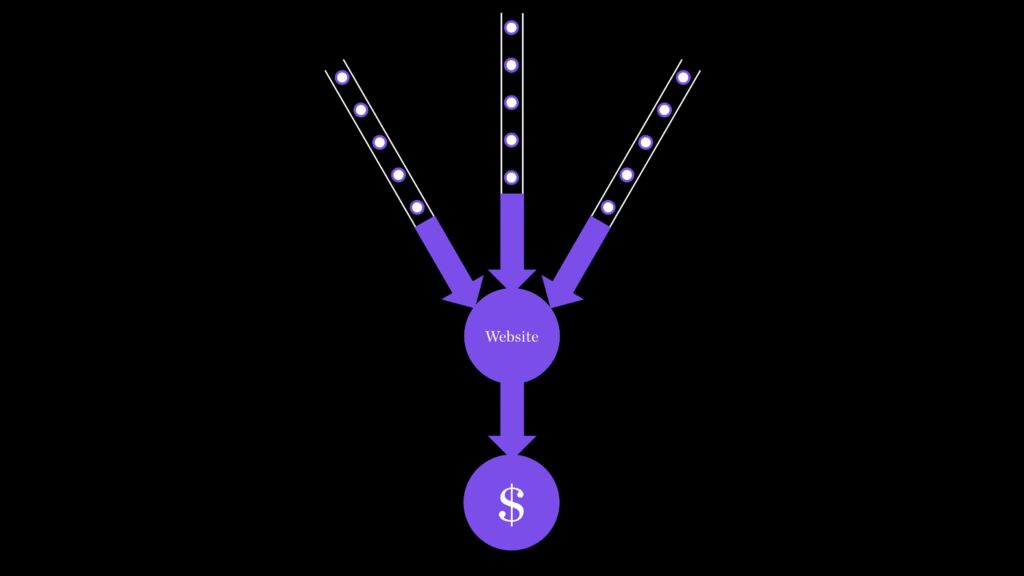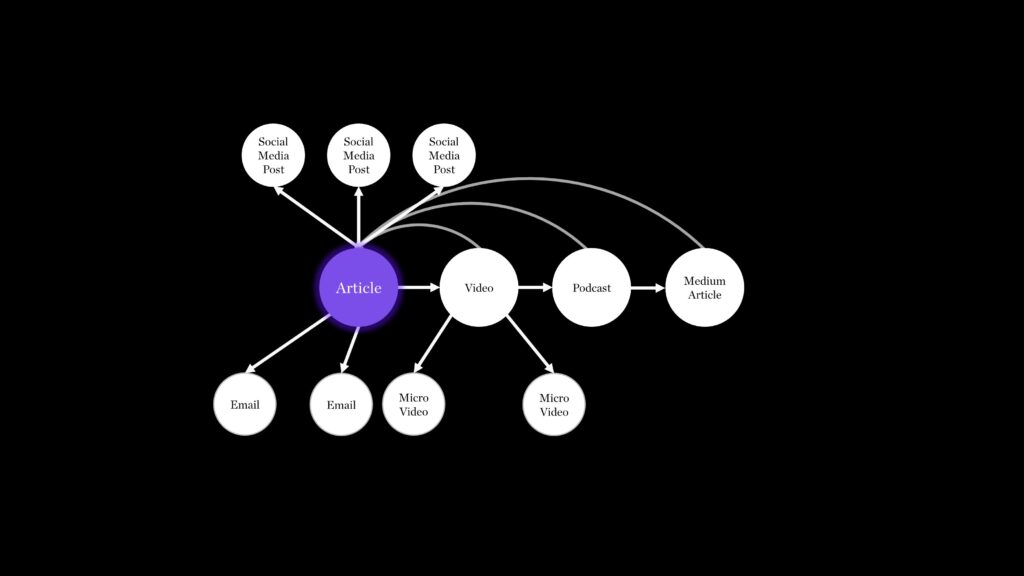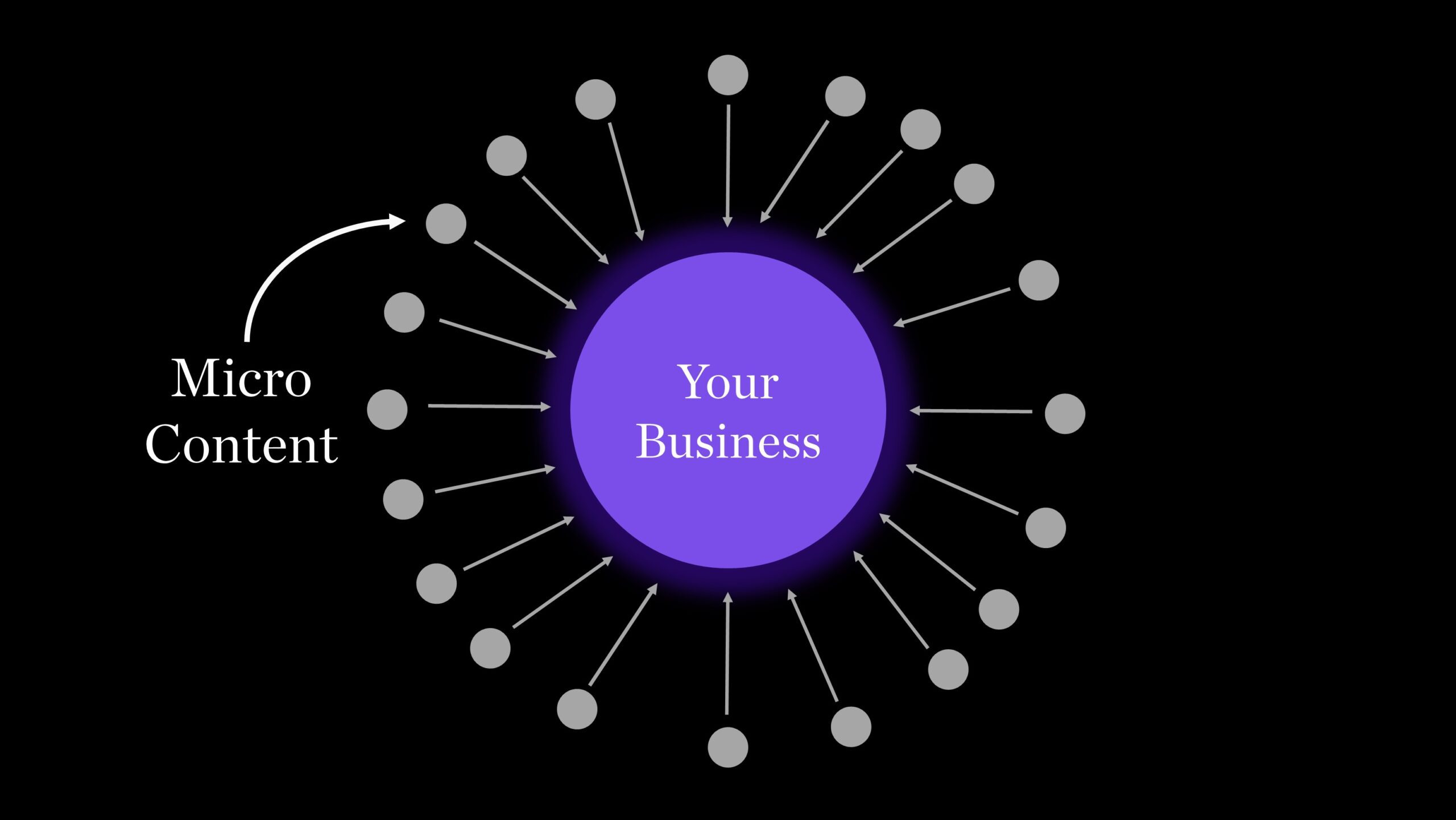Article last updated on October 4, 2022
Micro content is the new buzzword in content creation and marketing.
But what exactly does “micro content” mean? How can you utilize micro content marketing in your business? And what are some micro content ideas that will help you stand out from the crowd?

In this article, I’ll answer all these questions with my own experiences while working with clients on their Clarity Blueprint (growth strategy).
Just keep in mind that it does not matter if you have a personal brand or a business. This article applies to anyone who wants to create more value for their audience.
What Is Micro Content?
Micro content is written copy or video that can be consumed in under 30 seconds.
Today’s attention spans are shorter than ever before. We’re constantly bombarded by information.
We need quick answers to our problems. We want instant gratification. We don’t like to wait around.
So when we see something that promises us an immediate solution, we click on it. That’s why today’s businesses are creating micro content. It’s because they know how important it is to get someone’s attention right away.
Why Does Micro Content Matter?

If you’ve been following me for any length of time, then you know that I’m a huge fan of long-form content. Long-form content takes longer to read but provides much more value.
However, there’s a reason why most people prefer short-form content. They just aren’t willing to spend hours consuming it.
That’s why micro content is so powerful. At the same time, you could have up to 10 micro content pieces and have highly engaging posts for social media, or at the same time, you could have one 2000-word article.
That’s why micro content matters; it provides you with a higher output of content and helps you reach your ideal customer faster.
Now, after you understand the “what” and “why” behind micro content, let’s cover the main thing, which is micro content marketing for your business.
How To Use Micro Content Marketing In Your Business
Micro content marketing works best when used as part of a larger strategy.

For example, if you want to sell products online, then you should know the entire customer journey and what other brand components you need to include.
If your customer requires additional reasons to purchase from you, you should have an in-depth video about your product. That is a macro content.
The point here is that you shouldn’t use micro content marketing alone. It has to work within the bigger picture.
But, there are many ways to incorporate micro content marketing into your online business.
Micro blog posts
Think of these blog posts as condensed versions of your longer articles.
You can write them up to 10 times faster than a full post. But, make sure you still provide enough value to your readers.
These kinds of posts are great for building awareness on social media, especially on Twitter and LinkedIn.
One thing to remember here is that your introduction or hook for a micro-blog post matters a lot. If you don’t capture the reader’s interest with this first sentence, then they will quickly move on to another piece of content.
Usually, having a bold statement at the beginning of your post is a good way to start off. For example:
“The biggest mistake I see most people make is…”
“Here’s how you can…”
Here’s an example of a micro-blog post that I wrote on LinkedIn.
Micro videos
Another type of micro content that you can create is micro videos. These types of videos usually take between 10-30 seconds to watch.
They force you to focus only on one idea or message. This makes them perfect for YouTube Shorts, Instagram Reels, and TikTok, but they can also be good for LinkedIn or even Twitter, depending on who your target audience is.
This is a great way to get your message across without spending too much time creating something lengthy.
Micro videos usually have the biggest reach because engagement is high. So, if you’re looking for a quick win, then this is a great option.
Additionally, not that many people are comfortable creating videos, so if you manage to get over that hump, then you’ll find yourself doing well.
One thing that can help you is to plan out six videos ahead of time and then batch record them in one sitting. That way, you won’t feel overwhelmed and procrastinate.
If you do decide to go down this route, then make sure you keep things simple. Don’t try to explain everything in detail. Instead, just give straightforward, actionable steps to follow.
Micro content video examples
There are so many examples of video micro content that you could simply go to TikTok and type in the topic you are interested in, and then you will have an almost unlimited number of micro content video examples.
Here’s how to find them.
Micro podcasts
Podcasts don’t have to be 2+ hours long. They can be only 20 minutes long, focused on one topic.
And, it doesn’t matter what niche you are in. Podcasts are a great way to share valuable information with your customers.
You can use a podcast to interview experts in your industry, talk about trends, answer questions from listeners, etc.
To give you an example, Gary Bishop has podcast episodes that are just 7 minutes long. Of course, it has longer episodes, but mostly in micro podcast format.
Micro illustration
Illustrations have been slowly growing in popularity lately. Engagement on this type of micro post is one of the highest compared to other types of content.
Now, it may seem very easy to create a mini illustration, but it takes some practice to master.
You could go to Canva, find some templates, edit them a bit, and think you have created a masterpiece. But the engagement and response from your followers will tell you otherwise.
Let me give you an example here’s how professional looking micro illustration looks like.
Now, to be realistic, micro illustration would not yield directly to your revenue. But they will increase awareness of your social media presence and eventually lead to increase in revenue.
Importance of Micro Content Marketing Strategy
When I say strategy, I mean a plan of attack. You need to know where you want to go, when you want to start, and how you want to achieve your goals.

The first step is to define your goal. What do you want to accomplish? Do you want to build brand awareness? Or maybe you want to sell more products?
Next is to see how micro content fits into your overall marketing strategy.
Is there one social media platform that works better for your business than others? Is there a specific audience that you want to target?
Then, you should figure out which platforms work best for you. This will help you have a clear focus and direction.
Now it’s time to determine what type of micro content works the best based on your social media platform and how many pieces of content you are prepared to put out every day.
For example, if you are planning to post micro blog posts on Twitter (Threads), then you need to put out 4 threads per day, whereas on LinkedIn you need to post 2 micro blog posts. All social platforms have different approaches.
Your micro content should compliment your entire content strategy, not the other way around.
If your main content is long-form video content, then your micro content should bring awareness to your main video content.
Think of your core audience and what bite-sized content they prefer. Then, make sure your micro content aligns with their needs.
Once you have determined the number of micro content you are going to produce per day and what type of content fits perfectly, it’s time to make them.
Easiest Way to Generate Micro Content Ideas
One of the easiest ways to generate ideas for micro content is by using your content marketing efforts and breaking them down into bite-sized content.
If you have blog content that covers a certain topic, then you can easily turn it into multiple pieces of micro content.
Larger pieces of content can be a goldmine for new micro content.
What’s more, blog articles can be converted into audio content, Instagram Reel series, TikTok series, or multiple micro illustrations.
As you can see, one standalone piece of content can be a seed for multiple micro pieces.
I call this process “content atomization” but just make sure if you want to atomize the content to make relevant content to the main piece.

For example, if you have detailed articles about your industry, then you can easily convert those into a micro video series where you can cover all the subtopics within those articles.
I would just suggest that you use your original content as a model instead of copying it exactly.
Think of the main point of micro content, and that is to give straightforward information on a particular subject matter with a great hook at the beginning of each micro content piece.
So when you’re creating micro content, remember to keep it short, sweet, and simple.
Methods to Create Micro Content
If you don’t have macro content like in-depth articles or long form videos, there are still some simple methods to create micro content.
Making micro content should not be difficult. In fact, if it’s difficult, you are probably overcomplicating the entire process.
In order to help you with this process, I’m going to go over three simple but different methods to create any type of micro content.
Create a listicle

Listicles are very easy to create. All you need is a topic that can have steps or bullet points.
For example, let’s say you want to write a listicle about “3 little-known things that will sabotage your business growth.”
Then you just need to list them out, explain each point in one sentence, and give a recap at the end.
Listicle content is highly consumable. It’s short, sweet, and to the point. It also helps to keep people engaged.
Category POV

In my opinion, category POV is the most effective way to create micro content.
This method requires you to pick a category that you want to talk about and share your point of view.
You might not get the highest engagement, but you are building a reputation around your niche.
In your chosen category, share one commonly held belief that most people think is true (but is actually false or misunderstood).
Next, describe the problem in detail. Explain to the reader why this commonly held belief is so prevalent in society or how it became a commonly held belief in the first place. And finally, tell the reader what this commonly held belief has resulted in.
Don’ts and Dos

This type of content is very easy to make. If you want to help readers learn from your mistakes, then listing out all the don’ts and dos is a great way to start.
In this first sentence, tell the reader what they shouldn’t do if they want to achieve X.
Why not? Explain to the reader why they shouldn’t do this thing if they want to achieve X. What will happen if they make this mistake? Get specific.
Now tell the reader what they should do instead.
Tell the reader, if you could go back in time, what you would do differently. What should the reader do instead?
List off a few specific examples of how good life can be and what can be unlocked as a result of this decision.
There are many other methods to create micro content, but I’m afraid if I overwhelm you with too many examples, you will not know which one to use. So I’ll leave it up to you to decide which one works best for you.
Frequently Asked Questions
Here are some questions that come up frequently about micro content.
What is the meaning of micro content?
Micro content is written copy, images, and/or video content. The length of these pieces of content varies between 10-30 seconds. It’s usually used to promote products, services, and businesses.
How much does it cost to produce micro content?
If you use your phone camera to record yourself talking, you can easily create micro content for free. You can even edit videos for free. However, if you’re looking to create high-quality content, you may want to invest in a microphone or camera.
On top of that, you can hire someone to shoot your video for you. This costs money, but if you don’t have time to spend on creating content, then hiring someone else to do it for you may be worth it.
How long does it take to make micro content?
It depends on the size of the piece of content you’re making. A typical micro-blog post takes anywhere between a few minutes to a few hours to complete. The same goes for videos, it depends on your level of experience and the process involved in creating micro-content.
Can I just write a short paragraph and call it micro content?
Yes. Micro content can be a tweet or a short LinkedIn post, but always keep in mind your business objective. You don’t want to waste your time writing something that doesn’t add value to your business or your audience.
Are TikTok, Instagram Reels, and YouTube Shorts micro-content?
Yes. They are micro content because they are typically under 30 seconds. What’s more, they are mostly associated with the core term “micro content.” There are other types, but video micro content is the most popular one.
Do I need to create micro content every day?
No, but it’s important to remember that micro content is meant to be quick and concise. If you try to cram too much into each post, it won’t work.
If you don’t have time, focus on creating at least 3-5 posts per week. That way, you can still maintain a consistent flow of content.
My recommendation is to batch content creation over the course of several days. For example, you could create 10 posts in one sitting. Then record them one day and edit them the next. That way, you will have 10 completed posts, which you can schedule for over the next 2-3 weeks.
This will help you avoid burnout and ensure that you’re producing enough content without having to worry about running out of ideas.
Does my brand need to create micro content?
Most likely, your brand would benefit from creating micro content. In fact, this type of content helps build trust and authority within your niche.
You can also use micro content as an effective lead generation tool. When people see your content, they will be more likely to click through to your website or contact you.
Do I need to be an expert to create micro content?
No, anyone can create micro content. But if you’re going to create micro content, you must understand your target market.
You also need to be able to speak clearly and concisely. If you have trouble getting your point across, you won’t be able to make good content. One way to create content if you are not an expert is to share your experiences and progress.
How do you make micro content?
There are many ways to do it (as mentioned in this article), but the easiest is to use your original macro content, break it down into smaller pieces, and create micro content around those topics.
Who is a micro content creator?
There’s no single definition of what makes someone a micro content creator. It really comes down to actually creating micro content, and you are basically a creator.
But in general, micro content creators are usually people who are passionate about their industry. They love sharing their knowledge and expertise. They tend to be active online and are willing to engage with others. They are also open-minded and flexible.
Conclusion
Micro content marketing is a powerful tool that can help you reach your audience faster.
It’s important to note that micro content doesn’t mean low quality content. In fact, micro content is the compilation of your best work.
The key here is to find ways to share your knowledge and expertise with others through different mediums.
This way, you’ll reach a larger audience but never be attached to vanity metrics but your main business outcomes.
There’s no point in doing micro content marketing if you are not thinking about your core business objectives.


